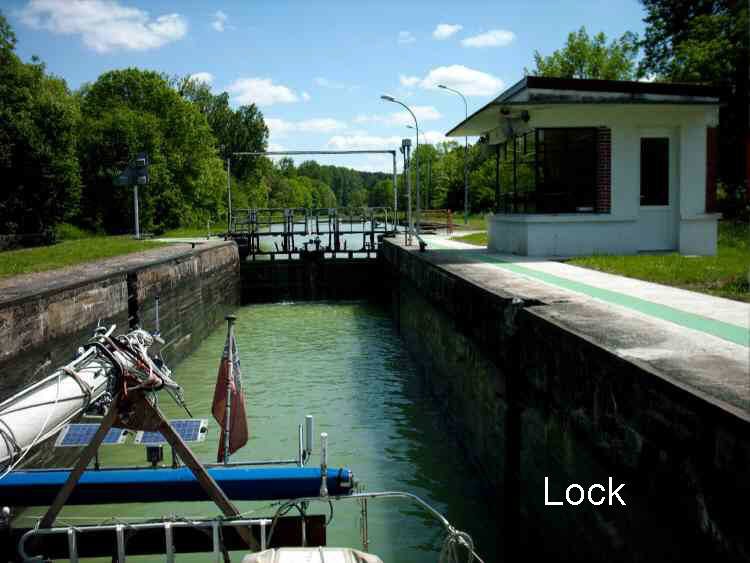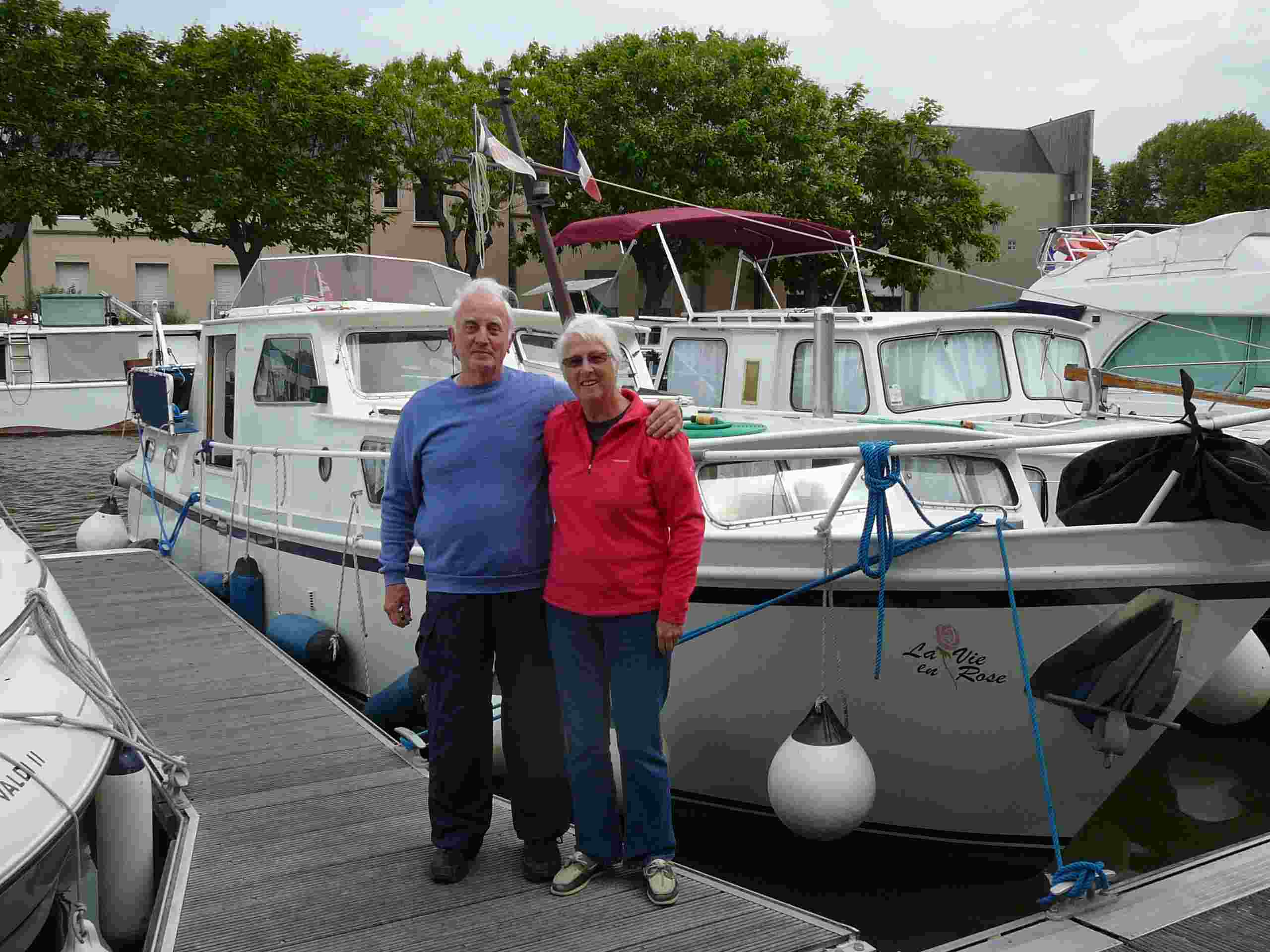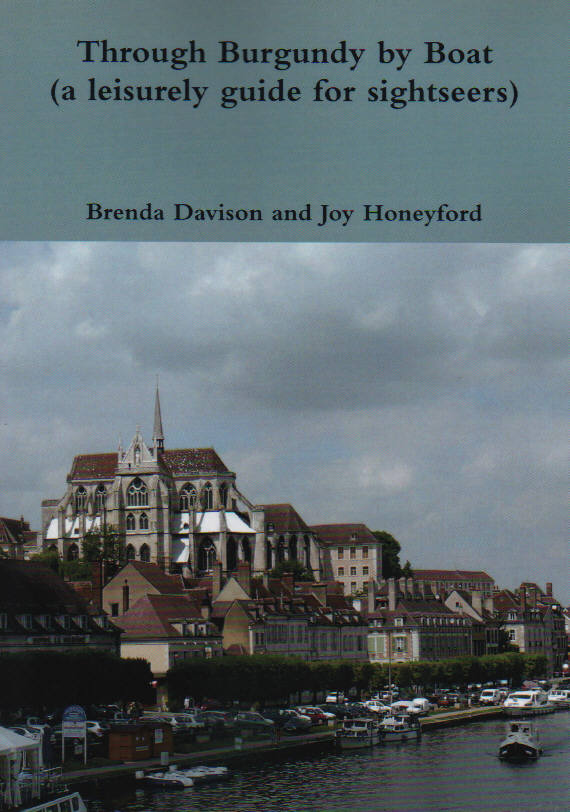Lock operation and opening hours
Locks in France are much easier to operate than the English ones and are generally in a better state of repair.
Lock operation
Always moor using two lines. It is good practice to attach the stern or centre line first as this halts the forward motion of the boat whilst still holding it against the lock wall. Attaching the forward line first is likely to result in the stern swinging away from the wall because of the boat's momentum. In practice this means that one of us steers the boat into the lock whilst the other has the stern line prepared. When the stern line has been attached the helmsman takes charge of this whilst the crew goes forward to attach the forward line.
Some boats keep the engine running in the lock and just use one line. This is not recommended practice and if there are other boats in the lock with you the wash from your engine may cause them to lose control and damage the boat - I speak from experience!
‘Lassoing’ the bollards from the cabin top is a preferable method to climbing ladders in the lock. To do this ensure that you have enough line to stretch from the boat to the bollard and back again and allow a little slack. The line should be heavy enough to throw. Divide this into two smooth coils between your hands, leaving a loop between them, and having no tangles. You then throw the loop which is between your hands over the bollard with a good forward motion, letting go of all but the end of the rope. Any spare rope can be coiled on deck making sure it does not coil around your legs or get caught on a deck cleat.
The first time Brenda tried this she overbalanced and ended up in the lock. Fortunately the gates were still open, it was a small lock and she still had the rope in her hands which was around the bollard, but it could have been nasty. So we recommend you practice on dry land first.

Various mooring devices are available from chandlers which allow you to put a line round a ring, a bollard, or rung of a ladder at a distance. We find the boat hook useful to drop the line round the bollard when it is out of reach. This year John has made a 'bollard grabber' to the design of some Australian friends (thanks Courlis). It is made from half of a small cycle wheel attached to a broom handle and is very useful when the bollards are set back, or the lock is too high. The rope sits nicely in the indentation of the wheel, one end is attached to the boat and the other is kept in your hand.
After the end of the line has been passed round the bollard and brought back to the boat it should be passed under a cleat or through a snap shackle otherwise if the boat should swing out into the lock because of water surge or wash from another boat you may not be able to hold it.

When approaching a lock the best position for the crew is on the side deck alongside the helmsman from where he can be 'talked in'. This is easier and much more effective than standing on the bows and then rushing back to get the line on.
The locks have bollards along the quay at either side. Sometimes these bollards have been worn away and you may have to change sides, so be prepared with ropes on both sides, ready attached. In deep locks the bollards are set into the walls of the lock and you need to transfer your lines as you move up or down, (Always make sure that at least one line is still attached) unless these are hydraulic bollards which move with the boat.
Opening Hours
The European directive on working hours means that lock-keepers now only work a 35 hour week. This has resulted in reduced lock and bridge opening hours of manually operated locks but a programme of automation is well in hand.
On the Rhône the locks are still open 12 hours per day so pleasure craft are unaffected.
Where locks are manually operated, the hours are generally 08.30 on weekdays and 09.00 on Sundays to 12.30, and 13.30 to 18.00 although there may be local variations and you will usually be given the times by the first lock keeper you encounter as you move from one section of the waterway to another. In practice we found that where we had a lock-keeper travelling with us through several locks we could negotiate lunch time with him/her so that we could moor up in a suitable place. If you are not in a hurry this lunch time stop can be very pleasant. The down side is that you cannot stop when you please and expect the lock keeper to wait until it suits you to move on. At the end of the day the lock-keeper will usually ask you at what time you wish to leave next day and will be waiting for you at the lock. During the high season sailing is ‘free’ which means that you do not have to notify the ‘programmation’ and can just turn up at the lock. These dates may well be advertised at moorings, or on the lockside.







